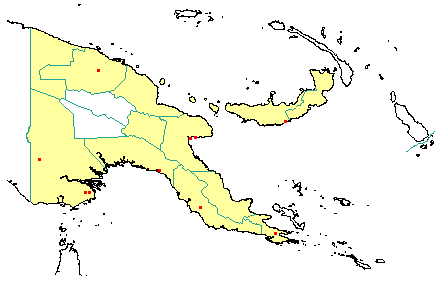
in PNGplants database
PNGTreesKey – Sterculia ampla Baker f. |
Barry Conn (NSW) & Kipiro Damas (LAE).
Guide to trees of Papua New Guinea
Copyright held by the authors, National Herbarium of New South Wales, and Papua New Guinea National Herbarium
Journal of Botany Vol. 61 Supplement 5: (1923)
Other Literature: Lembaga Penelitian Hutan 67-68 (1976)
Family: Malvaceae
Dicotyledon
Timber Group: Commercial hardwood
Field Characters: Small sub-canopy tree (up to 25 m high) or Large canopy tree (up to 40 m high); Bole cylindrical (40-70 cm diam.); straight (bole 15-30 m long); buttresses buttresses absent or buttresses present; spines spines absent; aerial roots aerial roots absent; stilt roots stilt roots absent; Bark grey or dark brown, rough, slightly tessellated, scaly or flaky, or pustular, lenticels elongated vertically; Subrhytidome (under-bark) red or green; less than 25 mm thick, 10.0-14.0; bark blaze consisting of one layer; strongly aromatic; pleasant; outer blaze white, with stripes, fibrous; inner blaze white, with stripes, fibrous; bark exudate (sap) present, colourless, not readily flowing (spotty), colour changing on exposure to air, to brown, not sticky; terminal buds not enclosed by leaves.
Indumentum: Complex hairs present, star-like (stellate) (to irregular (hairs reddish brown); stinging hairs absent; mature twig indumentum (hairs) present (with complex hairs), hairs dense to sparse.
Leaves: Leaves clustered at end of branches, spiral (leaves occurring singly at a node and arranged spirally up the branchlet), simple (a leaf composed of a single blade); petiole present, winged, attached to base of leaf blade, swollen (at tip and base); leaves broadest at or near middle, 17.0-43.0 cm, 12.0-42.0 cm; symmetric, entire, not dissected or lobed, sub acute or sub mucronate, venation palmate, secondary veins open, prominent, intramarginal veins absent; leaves lower surface pale green, upper surface pale green, indumentum (hairs) present, indumentum (hairs) somewhat dense or sparse; absent; domatia present, scattered along midrib; stipules present, free, laterally placed, not encircling the twig, scale-like, not fringed, large, not persistent.
Flowers: Inflorescence axillary, flowers on a branched axis, cones absent; flowers unisexual, unisexual with male and female flowers on the same plant, stalked, flowers with many planes of symmetry, (0.5-) 5.0-7.0 mm long, diameter small (up to10 mm diam.) (c. 3-4 mm diam.); perianth present, with all sepals and/or petals (hence tepals) similar, inner perianth red; 5, some or partly joined (forming a perianth tube and 5 perianth lobes); stamens 10-(male flowers)-15, absent, joined (to form a staminal tube around the ovary and style), free of the perianth; ovary superior, carpels separate (when more than one), locules 4; styles free, 4.
Fruits: Infrutescence arranged on branched axis, fruit 70.0-90.0 mm long, 60.0-65.0 mm diam., green (immature) or bright orange, not spiny (surface hairy), non-fleshy, aggregate, dehiscent, follicle; seeds 4 (c.), about 10 mm long, not winged, broad (as wide as long), seed 1-10 mm diam.
Distribution: West Sepik, East Sepik, Madang, Morobe, Eastern Highlands, Western, Gulf, Central, Northern, Milne Bay & New Britain.
 | Botanical records in PNGplants database |
Notes: Notes The genus Sterculia was previously classified in the family Sterculiaceae. Sterculia ampla is inadequately known and its taxonomic status is unclear.